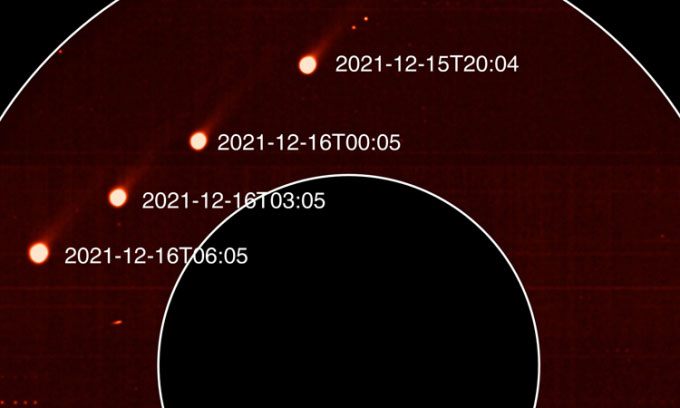The Solar Orbiter spacecraft flies through the tail of Comet Leonard, capturing images and providing valuable analyses for scientists.
As Comet Leonard bids farewell to Earth and flies past Venus, the Solar Orbiter, a solar research spacecraft from the European Space Agency (ESA), has soared through the long tail of the comet, delivering new insights to scientists.

The Solar Orbiter spacecraft captures images of Comet Leonard at different times in December 2021. (Photo: ESA/Solar Orbiter/Metis Team)
Leonard, also known as Comet C/2021 A1, was discovered in January of last year. For skywatchers, it was perhaps the most spectacular object to pass by in 2021. It put on an impressive “performance” during its journey towards the Sun, especially around December 12, when it was closest to Earth.
The Solar Orbiter collected data on the comet during the days surrounding December 17. At that time, Comet Leonard was moving away from Earth and heading toward the Sun, reaching its closest point to the Sun on January 3.
Meanwhile, the Solar Orbiter had completed its flyby of Earth on November 27 and is also on its way to the Sun for a close approach in March. Despite the comet’s nucleus being near Venus and about 44.5 million km away from the spacecraft in mid-December, the comet’s tail still extended through Earth’s orbit, according to ESA.
Samuel Grant, a researcher at University College London, anticipated that the Solar Orbiter would fly through the comet’s tail thanks to a computer program tracking the spacecraft’s trajectory, the comet’s orbit, and solar wind—the stream of charged particles continuously emitted by the Sun that shapes the ion tails of comets.
Although designed to study the Sun, the Solar Orbiter is equipped with several instruments capable of collecting data about Leonard’s tail. For instance, the spacecraft’s Solar Wind Analyzer detects ions and compounds associated with the comet rather than solar wind, including oxygen ions and CO2. Additionally, the spacecraft’s magnetometer recorded signs of magnetic disturbances that could be caused by the comet’s interaction with the Sun’s magnetic field.
Moreover, the Solar Orbiter captured several valuable images. The spacecraft collected ultraviolet images that can help scientists study water in the comet, as well as visible light images that provide further information about comet dust.
The Solar Orbiter is the only spacecraft to directly pass through the tail of Leonard, but many other spacecraft within the inner solar system have also studied this comet, including STEREO-A, Parker Solar Probe, and SOHO. For the Solar Orbiter, this marks the second time it has flown through a comet’s tail, having previously passed through the tail of Comet ATLAS in 2020 shortly after its launch.


















































